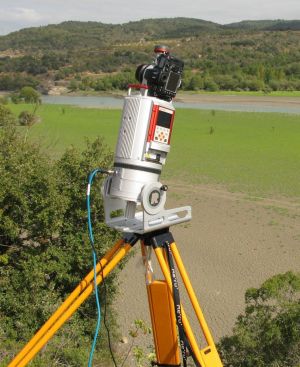Topography - Terrestrial Laser Scanner Riegl VZ-400
Jump to navigation
Jump to search
The printable version is no longer supported and may have rendering errors. Please update your browser bookmarks and please use the default browser print function instead.
Parameter to be measured:
- surface topography
Method:
- terrestrial laser scan
Equipment:
- Laser Scanner
- "internal" and external battery
- RiScan software
- Laptop, tripod, reflectors (not included)
Advantages:
- low power consumption: "internal" + external battery can provide almost a day of scanning
- backup-batteries can be added and removed during operation
- runs on 12 V, car-battery (adaptor supplied) can be used
- extensive function menu accessible directly over scanner display
- very quick overview and fine scans
- eye-safe IR-laser
- flash-design reminding Star-Wars fans of R2D2
- optional tilt-mount enables stable non-vertical (up to horizontal) device positions
- Laser plummet for precise locating of device
- widely configurable automativ recognition of reflective targets in overview scan and subsequent fine scan
- built-in Wireless option
- high scanning speed, comparatively large range
- sophisticated camera calibration options
- recording of multiple echos along laser path
- cables attached to non-moving part of scanner - no danger of "strangling" during rotation
- integrated GPS receiver
- support reflective cylinders as targets
Disadvantages:
- bulky and heavy: transport in the original box as ordinary flight baggage not possible; carrying in the field is painful
- IR laser has poor reflectivity (shorter range) on moist surfaces and snow
- operation via device panel becomes fiddly e.g. when manually selecting non-detected reflectors
- PC-software RiScan is complicated and non-intuitive (combines scanner operation, georeferencing and basic analysis); also used for other scanner models, but VZ-400 still missing in some dialog boxes
- only selection of rectangular scan areas possible (opposed to polygons)
- designed for use with reflective targets - use of non-reflective targets is a hassle
- sounds during operation do not match those of R2D2
What to watch out for:
- minimum range ~ 2 m
- laser beam can partially penetrate PE target spheres
- when using reflective cylinders as targets, the cylinders are assumed to have their axis parallel to z-direction of the scanner. If you use tilted instrument positions, use a calibrated tilt mount to "rotate" the tilted position back to normal, so the cylinders are oriented correctly
Problems/Questions:
Changing battery cells of Add-on Rechargeable Battery
After seven years of use, the Add-on Rechargeable Battery broke (charging no longer possible). Internally, they contain some standard Li-cells, which can be changed like this:
- remove Add-on Battery from scanner using long 8 mm Allen key in the
centre hole at the bottom
- unscrew the 6 outer and 4 inner tiny Torx screws (one of them is
slightly shorter, remember its place) on the Add-on battery
- open the lid: the lid holds some electronics and the jacks which are connected to the "mainboard" via a couple of connectors. These are holding the lid in place. I did not find any other way than carefully
prying out the lid with two sharp blades, resulting in some tiny scratches and dents along the lid. Alternatively, opening the small black plastic cap on the bottom opens a passage which might be used to push out the lid from inside - carefully check that you are pushing the lid, not some boards.
Price:
with Nikon DSLR and separate carrying case 104000 € (2010, Germany)
Links
Projects that used the above equipment:
Other related web sites:
